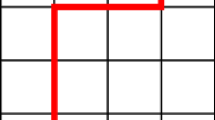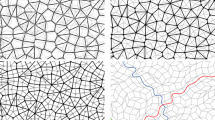Abstract
We characterize the classical Boltzmann distribution as the unique solution to a combinatorial Hodge theory problem in homological degree zero on a finite graph. By substituting for the graph a CW complex X and a choice of degree \(d \le \dim X\), we define by direct analogy a higher dimensional Boltzmann distribution \(\rho ^B\) as a certain real-valued cellular \((d-1)\)-cycle. We then give an explicit formula for \(\rho ^B\). We explain how these ideas relate to the Higher Kirchhoff Network Theorem of Catanzaro et al. (Homol Homotopy Appl 17:165–189, 2015). We also deduce an improved version of the Higher Matrix-Tree Theorems of Catanzaro et al. (Homol Homotopy Appl 17:165–189, 2015).
Similar content being viewed by others
Change history
24 July 2021
A Correction to this paper has been published: https://doi.org/10.1007/s41468-021-00074-2
Notes
See e.g., Oxley (1992), §1.8]. A previous draft of the paper had stronger assumptions on E. We are grateful to a referee for pointing out to us that non-degeneracy suffices.
The limit \(\beta \rightarrow \infty \) is called the low temperature limit (cf. Catanzaro et al. 2015).
This is slightly more general than the usual formulation. The classical least squares problem assumes that A is injective. We will be primarily concerned here with the case when A is surjective.
References
Ben-Israel, A., Greville, T.N.E.: Generalized Inverses, 2nd edn. Springer, New York (2003)
Ben-Tal, A., Teboulle, M.: A geometric property of the least squares solution of linear equations. Linear Algebra Appl. 139, 165–170 (1990)
Berg, L.: Three results in connection with inverse matrices. Linear Algebra Appl. 84, 63–77 (1986)
Catanzaro, M. J.: Ph. D. Thesis, Wayne State University (2016)
Catanzaro, M.J., Chernyak, V.Y., Klein, J.R.: Kirchhoff’s theorems in higher dimensions and Reidemeister torsion. Homol. Homotopy Appl. 17, 165–189 (2015)
Chernyak, V.Y., Klein, J.R., Sinitsyn, N.A.: Algebraic topology and the quantization of fluctuating currents. Adv. Math. 244, 791–822 (2013)
Cappell, S.E., Miller, E.Y.: Enumerative combinatorics of simplicial and cell complexes: Kirchhoff and Trent type theorems. arXiv:1506.03881 (2015)
Duval, A.M., Klivans, C.J., Martin, J.L.: Cellular spanning trees and Laplacians of cubical complexes. (English summary). Adv. Appl. Math. 46, 247–274 (2011)
Duval, A.M., Klivans, C.J., Martin, J.L.: Cuts and flows of cell complexes. J. Algebraic Combin. 41, 969–999 (2015)
Duval, A.M., Klivans, C.J., Martin, J.L.: Simplicial matrix-tree theorems. Trans. Am. Math. Soc. 361, 6073–6114 (2009)
Duval, A.M., Klivans, C.J., Martin, J.L.: Simplicial and cellular trees. Recent Trends in Combinatorics, vol. 159, pp. 713–752. IMA Vol. Math. Appl. Springer, New York (2016 )
Eckmann, B.: Harmonische Funktionen und Randwertaufgaben in einem Komplex. Comment. Math. Helv. 17, 240–255 (1945)
Kalai, G.: Enumeration of \({\mathbb{Q}}\)-acyclic simplicial complexes. Isr. J. Math. 45, 337–351 (1983)
Kelly, F.P.: Reversibility and Stochastic Networks. Wiley Series in Probability and Mathematical Statistics. Wiley, Chichester (1979)
Lyons, R.: Random complexes and \(\ell ^2\)-Betti numbers. J. Topol. Anal. 1, 153–175 (2009)
Moore, E.H.: On the reciprocal of the general algebraic matrix. Bull. Am. Math. Soc. 26, 394–395 (1920)
Mukherjee, S., Steenbergen, J.: Random walks on simplicial complexes and harmonics. Random Struct. Algorithms 49, 379–405 (2016)
Oxley, J.G.: Matroid Theory. Oxford University Press, Oxford (1992)
Parzanchevski, O., Rosenthal, R.: Simplicial complexes: spectrum, homology and random walks. Random Struct. Algorithms 50, 225–261 (2017)
Penrose, R.: A generalized inverse for matrices. Proc. Camb. Philos. Soc. 51, 406–413 (1955)
Petersson, A: Enumeration of spanning trees in simplicial complexes. Uppsala University preprint, May 18, 2009
Rosenthal, R.: Simplicial branching random walks and their applications. arXiv:1412.5406 (2014)
Ziegler, G.M.: Lectures on Polytopes. Graduate Texts in Mathematics, vol. 152. Springer, New York (1995)
Acknowledgements
We are indebted to a referee for valuable suggestions leading to a vastly improved version of the paper. Much of our writing was done while the last author was visiting the University of Copenhagen. He is indebted to Lars Hesselholt for providing him with support from the Niels Bohr Professorship. This material is based upon work supported by the National Science Foundation Grant CHE-1111350 and the Simons Foundation Collaboration Grant 317496.
Author information
Authors and Affiliations
Corresponding author
Ethics declarations
Conflict of interest
On behalf of all authors, the corresponding author states that there is no conflict of interest.
Appendices
Appendix 1: Kirchhoff–Boltzmann unification
For any fixed dimension d, the boundary operator \(\partial: \, C_{d}(X;{\mathbb {R}}) \rightarrow C_{d-1}(X;{\mathbb {R}})\) factors as
in which the first map is surjection and the second is an injection.
With respect to these inner product structures, one infers that the pseudo-inverse of \(\partial\!\!:\, C_{d}(X;{\mathbb {R}}) \rightarrow C_{d-1}(X;{\mathbb {R}})\) is given by the composition
consisting of the pseudo-inverses of i and p. (cf. Ben-Israel and Greville 2003, p. 48, ex. 17). Here, \(p_W^+\) is the pseudo-inverse of p with respect to the modified inner product structure on \(C_{d}(X;{\mathbb {R}})\) (cf. Remarks 3.2 and 3.5). Similarly, \(i_E^+\) is the pseudo-inverse for i defined using the modified inner product on \(C_{d-1}(X;{\mathbb {R}})\).
Therefore, all three pseudo-inverse formulas will follow from one, e.g., from the formula for the surjection, since the formula for an injection can be obtained by taking transposes and applying duality (Lemma 4.5), whereas the general pseudo-inverse is obtained by taking the composition.
For a tree \(T \in {{\mathcal {F}}}_d(X)\), the composition
is an isomorphism. Let \(\alpha _T\) denote its inverse. Let \(\varphi _{T}: B_{d-1}(X; {\mathbb {R}}) \rightarrow C_{d}(X; {\mathbb {R}})\) be the composition
Then using Theorem 3.3 one has
where the sum is over spanning trees \(T \in {{\mathcal {F}}}_d(X)\).
Similarly, the pseudo-inverse of the inclusion \(i: B_{d-1}(X;{\mathbb {R}}) \rightarrow C_{d-1}(X;{\mathbb {R}})\) is obtained as follows: for a co-tree \(L \in {{\mathcal {F}}}_{d-1}^{*}(X)\) the composition
is an isomorphism; let \(\beta _L\) denote its inverse. Let \(\zeta _{L}: C_{d-1}(X; {\mathbb {R}}) \rightarrow B_{d-1}(X; {\mathbb {R}})\) be the composition
where the first map is the quotient homomorphism.
Then
where the sum is over spanning co-trees \(L \in {{\mathcal {F}}}_{d-1}^{*}(X)\).
Combining (25) and (26) with the pseudo-inverse composition property we arrive at a formula which encompasses both the Boltzmann splitting formula (Theorem A) and the higher Kirchhoff projection formula of Catanzaro et al. (2015, thm. A):
Theorem 5.3
(Kirchhoff–Boltzmann Projection Formula) The pseudo-inverse of the boundary operator \(\partial\!\!:\, C_d(X;{\mathbb {R}}) \rightarrow C_{d-1}(X;{\mathbb {R}})\) with respect to the modified inner products defined by E and W is given by
where \( \sigma _{L, T} = \varphi _{T}\circ \zeta _{L}: C_{d-1}(X; {\mathbb {R}}) \rightarrow C_{d}(X; {\mathbb {R}})\) and the sum is indexed over \(L \in {{\mathcal {F}}}_{d-1}^{*}(X)\) and \(T \in {{\mathcal {F}}}_d(X)\).
Remark 5.4
Theorem 5.3 gives a concrete expression for the average current in the case of periodic stochastic driving (in the adiabatic limit) (Chernyak et al. 2013). Let \(\gamma \) be a smooth 1-dimensional cycle in the vector space of parameters (E, W) and let \(\hat{x} \in Z_{d-1}(X;{\mathbb {Z}})\) be a \((d-1)\)-cycle. Let \(x = [\hat{x}] \in H_{d-1}(X;{\mathbb {Z}})\) be the associated homology class. Then the average current of \((\gamma ,[x])\) is defined to be the d-cycle
where \(A = A(E,W) = e^{-W}\partial ^{*}e^{E}{{\mathcal {L}}}_{E, W}^{-1}\) is the operator of equation (19) and \(\rho ^{\mathrm{B}}\) is the higher Boltzmann distribution of x (see Chernyak et al. 2013) if \(d = \dim X = 1\) and (Catanzaro 2016) for \(d > 1\).). Then, after some straightforward algebraic manipulation using Theorem 5.3, we find
where \(\varrho _{T}^{+} = \varrho _{T}^{+}(W) := w_T/\Delta _T, \varrho _{L}^{-} = \varrho _{L}^{-}(E) := \tau _L/\nabla _L\) and \(\alpha \) is any smooth 2-dimensional chain in the space of parameters satisfying \(\partial \alpha = \gamma \).
Appendix 2: connection with a result of Lyons
In this section we show how Corollary D is equivalent to the second formula of Lyons (2009, cor. 6.2). The latter result is the statement that the determinant of the restricted Laplacian \({\mathcal {L}}:\,B_{d-1}(X;{\mathbb {Q}}) \rightarrow B_{d-1}(X;{\mathbb {Q}})\) coincides with
where
-
\(\theta _k(Y)\) is the order of the torsion subgroup of \(H_k(Y;{{\mathbb {Z}}})\);
-
\(h_{d-1}(X) := \sum _T \theta _{d-1}(T)^2\) and the sum is indexed over all spanning trees T of X in dimension d;
-
\(h_{d-2}'(X) := \sum _L \theta _{d-2}(L)^2t_{d-1}'(L^c)^2\, ,\) where the latter sum is indexed over all spanning co-trees L of X in dimension \(d-1\);
-
the number \(t_{d-1}'(L^c)\) that appears in the definition of \(h_{d-2}'(X)\) is the order of the finite abelian group
$$\begin{aligned} Z_{d-1}(X;{{\mathbb {Z}}})/(Z_{d-1}(X;{{\mathbb {Z}}})\cap B_{d-1}(X;{{\mathbb {Q}}}) + Z_{d-1}(L;{{\mathbb {Z}}})) \, . \end{aligned}$$
(Note: \(\theta _k(Y)\) is the same as Lyons’ \(t_k(Y)\).)
It is straightforward to check that the two results are equivalent if the identity
holds for every such spanning co-tree L, where we recall that \(a_L\) is the order of \(H_{d-1}(X,L;{{\mathbb {Z}}})\).
The argument proceeds as follows. Unravelling the proof of Lyons (2009, lem. 6.1), one discovers that \(t_{d-1}'(L^c)\) coincides with the order of the cokernel of the injective homomorphism
where \(T_{d-1}(X;{{\mathbb {Z}}}) \subset H_{d-1}(X;{{\mathbb {Z}}})\) is the torsion subgroup.
Consider the commutative diagram

having exact rows and columns, where homology is taken with integer coefficients. The homomorphisms labelled by \(\rightarrowtail \) are injective and those labelled by \(\twoheadrightarrow \) are surjective. The injectivity of \(H_{d-1}(L) \rightarrow H_{d-1}(X)\) and \(H_{d-1}(L) \rightarrow H_{d-1}(X)/T_{d-1}(X)\) is implied by the spanning co-tree axioms.
Let \(q_L\) denote the order of \(H_{d-1}(X,L)/T_{d-1}(X)\). Truncating the third row in the middle, we obtain an exact sequence
which implies the identity
Exactness of the middle column implies
The identity (28) now follows by inserting (30) into (29). \(\square \)
Rights and permissions
About this article
Cite this article
Catanzaro, M.J., Chernyak, V.Y. & Klein, J.R. A higher Boltzmann distribution. J Appl. and Comput. Topology 1, 215–240 (2017). https://doi.org/10.1007/s41468-017-0006-9
Received:
Accepted:
Published:
Issue Date:
DOI: https://doi.org/10.1007/s41468-017-0006-9




